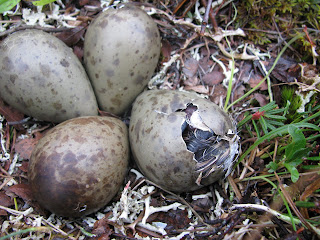
Sunday, July 25
Aurora and More

Sunday, July 11
Chicks Galore!

It's been a very busy few weeks here since all our Godwit nests have been hatching, along with most other nesting species here. Over the past few weeks, as we've been regularly checking our 14 remaining nests (12 were depredated or abandoned so far), the adult birds have been increasingly attached to their nests, such that when we go to check the eggs' status, we would literally have to bend over and reach out to grab the incubating bird before it would leave the nest, with loud, grating squawks, to hover threateningly above our heads as we worked.
There are certain distinct levels of hatching that we must ascertain at each nest to be sure we are there within an hour or so of the chicks' hatch. About ten to fifteen days prior to hatch, the eggs can be suspended in water, and soon after, they begin to float. By measuring the floating height, we can get a rough estimate of when the egg will hatch. For example, if 8mm of the egg is above the surface, it is about 5 days till hatch. Three to four days out, the eggs will begin to show "star-cracks," or "pips," which are when you can see fine cracks in the wide end of the shell where the bird has begun to peck its way out. A day or two before, you can often see the bill poking through a small hole, or even watch the bird struggling inside. It's quite a remarkable thing to behold, a new life literally breaking itself out of a tiny egg, with its head still crammed between its two huge feet.
"Star-cracked" Godwit eggs -Photo (C) Shawn Billerman
Photo by Shawn Billerman
From each nest, we put a tiny radio transmitter on one chick, at the small of its back, between the uropygial gland below and the curve of its spine above. The radio, which transmits a metallic beep to the receiver every second or so, is attached to a small patch of gauze (about 10 by 15mm) which is in turn glued to the bird with a special, quick-drying, salt-water-proof glue (which happened to rip my gloves when I got a tiny drop between two fingers).
If we get to a hatched nest within a few hours, we can easily pick up a handful of four little chicks straight from the nest cup and band them, attaching a radio to one. However, if we miss that brief window, the chicks could easily evade us for the rest of the summer. As testament to the chicks' quickly-acquired talent and fervor for long-distance travel, we resighted the parents of a nest we had banded chicks from, tuned our receiver to that chick's radio frequency to confirm that it was indeed with the agitated parents, and got out the GPS to see how far we were from their nest; just 36 hours after hatching, the 25-gram chick had travelled over 3 kilometers across the Fen, which, to a 3-inch ball of fluff and legs, is nothing short of mountainous terrain. It is quite amazing to see this bird's innate inclination for extreme distance travel so apparent on the first day of its life.
Since, as of today, we now only have one nest that has not fully hatched yet, most of our work for the rest of the season will consist of tracking the chicks and doing habitat surveys where we find them. So far, we haven't done any of the habitat surveys, but essentially, once we've taken three compass bearings to triangulate the location of the transmitter (or rather, the chick carrying it), we identify the plant species present and their relative abundance, as well as water levels and such. We will recapture the radio chick from each brood once per week to take new measurements and follow their growth until they fledge, which can often be a lot more work than it seems.
The other day, Nathan and I were following a chick for its first recap (one week after hatch). I was holding the receiver and antenna to get some practice with close range telemetry, and the chick just kept leading me in circles around the edge of the fen, where the lichen mounds were tall and frequent as the habitat transitioned to the thicker adjacent boreal forest. "We've got time, don't worry about it," Nathan said. Well, after some more circles, to my relief, he said, "Okay, let me do it." I was hoping he would at least have a little trouble with this bird- it would be discouraging to have so much difficulty with a really easy bird, of course. As it turns out, I got more than I had bargained for. There were several occasions where the signal was louder when we pointed the antenna at our feet than in front of us, indicating we were practically on top of the chick. Then all of a sudden the signal would fade and it would lead us both back in another direction. We eventually followed this chick for about 45 minutes, through a few hundred meters of boreal forest and across a dirt road, in the opposite direction of the fen, to finally find it hiding under a fallen spruce. "MM," as he was flagged, definitely has a good set of genes going for him; I'll be watching for his return next year, after he's logged another 20,000 miles or so.
Least Sandpiper chick
Luckily, there are still chicks to come, as evidenced by these incubating parents; they just happen to be the kind that don't contribute to our project or our work load:
American Golden-plover















